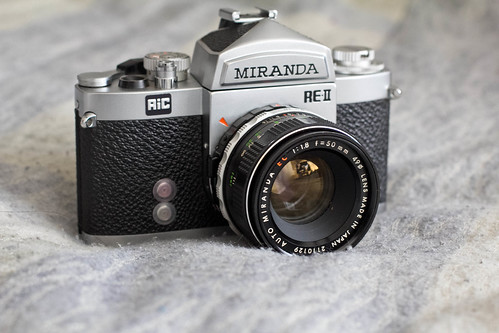Miranda RE-II

|
| Miranda RE-II image by moodybq (Image rights) |
The 1975 Miranda RE II was the last in a long line of cameras that started with the Miranda T. The final group of this family were the Sensomats, beginning with the 1969 Sensomat, which added stop-down TTL metering. The Sensomat's controls were refined in 1971 to become the Sensomat RE. The 1975 RE II abandoned the Sensomat name, and was something different.
Whilst retaining compatibility with the original prism/finder housing (featured in the T through to the Fv), it used EC lenses (developed for the radically revised dx-3) to offer full aperture metering, and abandoned some of the legacy features that had otherwise been perpetuated by the Sensomat family, such as the second shutter release button on the front of the camera.
In brief, the RE-II offers a manual, viewfinder centre-the-needle, open aperture, TTL metering exposure system, with a partial, bottom-weighted metering pattern, which requires Miranda EC (or E) lenses to work. As found in the Auto Sensorex EE, the meter does not couple across the entire range of settings at all film speeds (e.g. you cannot select 1/1000th at film speeds of 80 ASA and below, nor 1 sec., at film speeds of 250 ASA and above, etc.). The camera body is compatible with older Miranda accessories, including the original interchangeable VF viewfinders. The RE II got a dedicated prism finder that incorporated a hot shoe.
The viewfinder focusing screen comprises a central micro-prism spot, surrounded by a micro-prism ring, and the effect of this is like a two-way split screen. When the camera is out of focus, the central part of the image misaligns on both the horizontal and vertical planes. This system was patented by Miranda, used in the dx-3, and named the Quadrascopic Image System (QIS) rangefinder.
The RE-II was sold with either an f/1.8 or an f/1.4 50mm EC lens, and was probably produced until 1976, when Miranda became bankrupt.